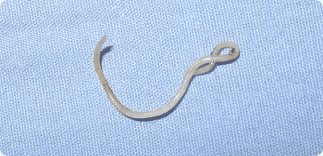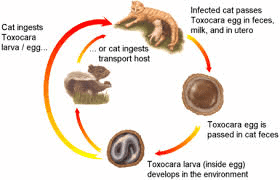There are two species of roundworms affecting cats and kittens: Toxocara cati and Toxascaris leonina. Toxocara cati is generally felt to be more harmful to cats but Toxascaris leonina is able to infect both dogs and cats. It is helpful to distinguish their eggs under the microscope so as to know which medications to use and which additional pets are at risk. There is overlap in treatment protocols with some dewormers but not with others.
Even though roundworms are occasionally passed or vomited up, most of the time these worms are unseen in the cat’s intestinal tract; do not expect to see any sign of them in the litter box or in fecal material. You will most likely never know they are there unless you test for them.
How Infection Occurs

In cats, there are three ways by which infection with Toxocara cati occurs:
- Consuming infective worm eggs from soil in the environment, generally through normal grooming.
- Nursing from a mother cat that was herself infected in late pregnancy; most kittens are infected this way.
- Consuming a prey animal – usually a rodent – that is carrying developing worms.
Note: dogs cannot be infected with Toxocara cati. They have their own roundworm called Toxocara canis.
Why Is Infection Bad?
Roundworm infection can have numerous negative effects. It is a common cause of diarrhea in young animals and can cause vomiting as well. Sometimes the worms themselves are vomited up, which can be alarming as they can be quite large with females reaching lengths of up to seven inches. The worms consume the host’s food and can lead to unthriftiness and a classical pot-bellied appearance. Heavy infections can lead to pneumonia as the worms migrate and, if there are enough worms, the intestine can actually become obstructed.
Human infection by this parasite is especially serious (see below). It is important to minimize the contamination of environmental soil with the feces of infected animals so as to reduce the exposure hazard to both humans and other animals. A classical source of infection is a child’s outdoor sandbox, in which outdoor cats may defecate.
Life As A Roundworm
Toxocara cati has one of the most amazing life cycles in the animal kingdom. It is crucial to understand this life cycle if effective treatment is to be pursued.

Step One: The Worm Egg Develops An Embryo
Toxocara eggs are passed in the host’s feces. If a fecal sample is tested, it is possible to detect the eggs and confirm roundworm infection. The embryonic worm develops in the outdoor environment inside its microscopic egg for 2 to 4 weeks before it can infect a new host. Toxocara eggs are famous for weathering harsh environmental conditions, so they may remain infectious for a long time after their one-month egg development is complete and long after any visible fecal matter has melted into the surrounding dirt. Eggs can remain infective for months to years.
Fresh feces are NOT infectious. But older feces ARE
Step Two: The Worm Enters The Cat
The egg, containing what is called a second stage larva, is picked up orally by a cat or by some other animal. The egg hatches in the new host’s intestinal tract and the young worm burrows its way out of the intestinal tract to encyst in the host’s other body tissues. If the new host is a cat, the life cycle proceeds. If the new host is a member of another species, such as a rodent, the larvae wait encysted until the new host is eaten by a cat. These prey animals that carry worm larvae are called paratenic or transport hosts. The cat is called the definitive host.
Step Three: The Young Worm Migrates Through The Cat’s Body
At this point the second stage larva has entered the cat’s body, broken out of the intestinal tract where it entered the cat’s body, and is ready to migrate. Some larvae simply migrate to the nearby liver and encyst there. Others move to the mammary gland (see later) but the majority will head for the cat’s lungs and have made it there within three days of entering the cat. Once they get to the lung, they develop into third stage larvae and burrow into the small airways, ultimately traveling upward towards the host’s throat. A heavy infection can produce a serious pneumonia. When they get to the upper airways, the cat starts coughing. The worms are coughed up into the host’s throat where they are swallowed, thus entering the intestinal tract for the second time in their development.
When cats are dewormed, this affects onlyworms in the intestinal tract. It does not affect encysted larvae. It is difficult to prevent mother-to-kitten transmission and routine deworming is not adequate.
If the host is a nursing mother, second stage larvae can migrate to the mammary gland instead of the lung. Kittens can thus be infected by drinking their mother’s milk. Larvae that had encysted in the liver and gone dormant will re-awaken during the host’s pregnancy, continuing their migration just in time to infect the nursing kittens. In this way, a well dewormed mother cat can still find herself infecting her kittens.
Step Four: Worms Mate And Lay Eggs of Their Own!
Once back in the intestine, the larvae complete their maturation and begin to mate. The first eggs are laid about one week after the fourth stage larvae have arrived in the intestine and about four to five weeks after infection has first occurred. From here the cycle repeats.
How Do We Know If Our Cat Is Infected?
You may not know and this is one of the arguments in favor of regular deworming. Regular deworming is especially recommended for cats that hunt and might consume the flesh of hosts carrying worm larvae. Kittens are frequently simply assumed to be infected and automatically dewormed.
Of course, there are ways to find out if your pet is infected. If a cat or kitten vomits up a worm, there is a good chance this is a roundworm (especially in a kitten). Roundworms are long, white and described as looking like spaghetti. Tapeworms can also be vomited up but these are flat and obviously segmented. If you are not sure what type of worm you are seeing, bring it to your vet’s office for identification.
Fecal testing for worm eggs is a must for kittens and a good idea for adult cats having their annual check up. Obviously, if there are worms, they must be laying eggs in order to be detected but, by and large, fecal testing is a reliable method of detection.
How Do We Get Rid Of Roundworms?
Numerous deworming products are effective. Some are over the counter and some are prescription. Many flea control and/or heartworm prevention products provide a monthly deworming, which is especially helpful in minimizing environmental contamination. Common active medications / ingredients include:
- Pyrantel pamoate (active ingredient in Strongid®, Nemex®, Heartgard Plus®, Drontal®, HeartgardPlus® and others)
- Piperazine (active ingredient in many over the counter products)
- Fenbendazole (active ingredient in Panacur®)
- Selamectin (active ingredient in Revolution®)
- Emodepside (active ingredient in Profender®)
- Moxidectin (active ingredient in Advantage Multi®)
- Eprinomectin (active ingredient in Centragard®)
- Milbemycin oxime (active ingredient in Interceptor®)
There are two important concepts to keep in mind about deworming. Medications essentially anesthetize the worm so that it lets go of its grip on the host’s intestine and it passes out with the stool. Once it has been passed, it cannot survive in the environment and dies. This means that you will likely see the worms when they pass so be prepared; they can be quite long and still be alive and moving when you see them.
The other concept stems from the fact that larvae in migration cannot be killed by most deworming products. After the worms are cleared from the intestine, they will be replaced by new worms completing their migration. This means that a second, and sometimes even a third, deworming is needed to keep the intestine clear. The follow-up deworming is generally given several weeks following the first deworming to allow for migrating worms to arrive in the intestine where they are vulnerable.
Do not forget your follow-up deworming. Almost all of the dewormers commonly used require repeat deworming.
The Companion Animal Parasite Council recommends that routine deworming of kittens begins at age 2 weeks to prevent hookworm infection and then the kittens should be placed on a monthly heartworm preventive that includes protection/deworming against Toxocara cati.
Toxascaris leonina can infect both dogs and cats alike.
As with Toxocara cati, diarrhea can result from Toxascaris leonina and deworming is needed to control symptoms and prevent contagion.
Many of the newer deworming products are not labeled for use against Toxascaris leonina, which does not necessarily mean that they do not work but here are the reliable classics that have been used for decades with efficacy:
- Pyrantel pamoate (active ingredient in Strongid®, Nemex®, Drontal®, Heartgard® and others)
- Fenbendazole (active ingredient in Panacur®)
Because Toxocara migrates through the body, a sequence of deworming is typically performed so as to get all the larvae that were migrating at the time of the earlier deworming. Because Toxascaris does not migrate, only one deworming should cover it. Of course, a known infection of either worm suggests a contaminated environment, which is why the Companion Animal Parasite Council recommends regular deworming for pet dogs and cats.


